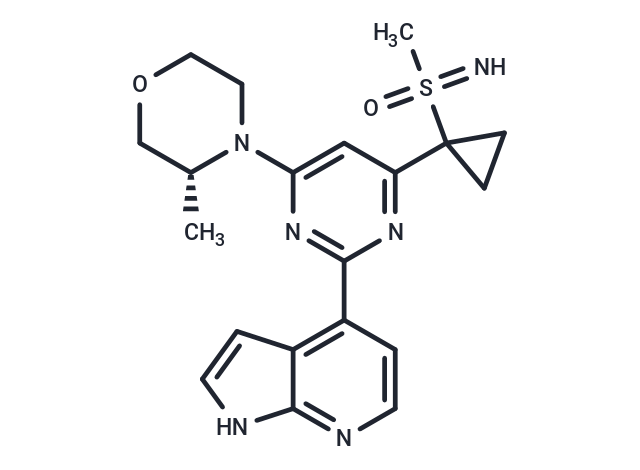Shopping Cart
- Remove All
 Your shopping cart is currently empty
Your shopping cart is currently empty

Ceralasertib (AZD6738) is an orally active, selective ATR kinase inhibitor with an IC50 of 1 nM.

| Pack Size | Price | Availability | Quantity |
|---|---|---|---|
| 1 mg | $43 | In Stock | |
| 5 mg | $97 | In Stock | |
| 10 mg | $148 | In Stock | |
| 50 mg | $439 | In Stock |
| Description | Ceralasertib (AZD6738) is an orally active, selective ATR kinase inhibitor with an IC50 of 1 nM. |
| Targets&IC50 | ATR:1 nM |
| In vitro | METHODS: 276 different tumor cell lines were treated with Ceralasertib for 3 days and cell viability was measured by MTS assay. RESULTS: For most cell lines, the median GI50 for 50% growth inhibition (1.47 µmol/L) was higher than the IC90 for ATR cells, with only 13% of the cell lines having a GI50 below the median, and 30% below 1 µmol/L. Hematological cell lines (median GI50= 0.82 µmol/L) generally showed increased sensitivity compared to solid tumor cells (median GI50= 1.68 µmol/L). [1] METHODS: Colorectal cancer cells HT29 were treated with trifluridine (70 µM) and Ceralasertib (0.5 µM) for 48 h, and the expression levels of target proteins were measured by Western Blot. RESULTS: The trifluridine+Ceralasertib group inhibited Chk1 phosphorylation in HT29 cells at 48 h compared to the trifluridine group. Therefore, it was confirmed that Ceralasertib inhibited Chk1 phosphorylation. In HT29 and HCT116 cells, DNA damage was more severe in the trifluridine+Ceralasertib group than in the trifluridine group, which could be confirmed by the increased level of γH2A expression. [2] |
| In vivo | METHODS: To assay anti-tumor activity in vivo, Ceralasertib (10-50 mg/kg, 10% DMSO+40% Propylene Glycol+50% deionized water) was orally administered to LoVo, Granta-519, NCI-H23, or 549 xenograft-carrying athymic nude mice bearing LoVo, Granta-519, NCI-H23 or 549 xenografts once daily for 14-28 days. RESULTS: LoVo and Granta-519 showed dose-dependent efficacy, with significant TGI at 50 mg/kg, moderate activity at 25 mg/kg, and no activity at 10 mg/kg. Significant antitumor activity was also observed in NCI-H23 but not in A549 model. [1] |
| Kinase Assay | General procedure for the EC50 test: DDR1 is induced by 2 Gg/ml doxycycline for 48 hrs prior to DDR1 activation by rat tail collagen I. The DDR1 over-expressed U2OS is pre-treated by media containing each concentration of the compound for 1 hr and treated by changing the media to the EC50 test media containing 10 Gg/ml collagen and each concentration of the compound for 2 hrs. Each cells is washed with cold PBS three times and lysed with the lysis buffer (50 mMTris, pH 7.5, 1% Triton X-100, 0.1% SDS, 150 mM NaCl, 5 mM EDTA, 100 mMNaF, 2 mM Na3VO4, 1 mM PMSF, 10 Gg/ml aprotinin, and 10 Gg/ml leupeptin). The activation of DDR1 is quantified by density using program ImageJ to determine EC50 following Western blot using anti-activated human DDR1b (Y513). |
| Cell Research | Cells are treated in white walled, clear bottom 96-well plates with the indicated doses of AZD6738, cisplatin, gemcitabine, or combination for 48 h. ATP levels are assessed as surrogate measure of viability was assessed using the CellTiter-Glo Luminescent Cell Viability Assay and Safire 2 plate reader. Raw data are corrected for background luminescence prior to further analysis. For AZD6738 treatment, log dose response curves are generated in GraphPad Prism 6 by nonlinear regression (log(inhibitor) vs. response with variable slope) of log-transformed (x = log(x)) data normalized to the mean of untreated controls. GI values, defined as the dose X at which Y = 50%, were extrapolated from dose response curves. |
| Alias | AZD6738 |
| Molecular Weight | 412.51 |
| Formula | C20H24N6O2S |
| Cas No. | 1352226-88-0 |
| Smiles | C[C@@H]1COCCN1c1cc(nc(n1)-c1ccnc2[nH]ccc12)C1(CC1)S(C)(=N)=O |
| Relative Density. | 1.52 g/cm3 (Predicted) |
| Storage | Powder: -20°C for 3 years | In solvent: -80°C for 1 year | Shipping with blue ice. | |||||||||||||||||||||||||
| Solubility Information | H2O: < 1 mg/mL (insoluble or slightly soluble) Ethanol: 39 mg/mL (94.54 mM), Sonication is recommended. 10% DMSO+40% PEG300+5% Tween 80+45% Saline: 7.6 mg/mL (18.42 mM), In vivo: Please add the solvents sequentially, clarifying the solution as much as possible before adding the next one. Dissolve by heating and/or sonication if necessary. Working solution is recommended to be prepared and used immediately. DMSO: 55 mg/mL (133.33 mM), Sonication is recommended. | |||||||||||||||||||||||||
Solution Preparation Table | ||||||||||||||||||||||||||
Ethanol/DMSO
DMSO
| ||||||||||||||||||||||||||

Copyright © 2015-2025 TargetMol Chemicals Inc. All Rights Reserved.